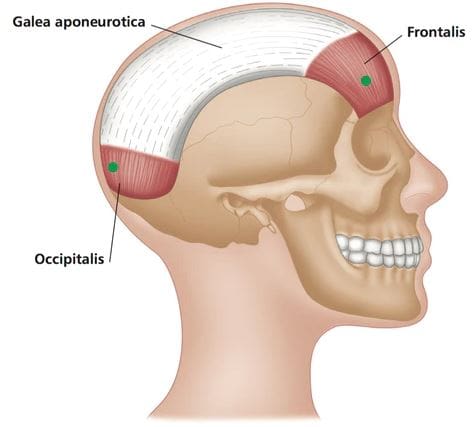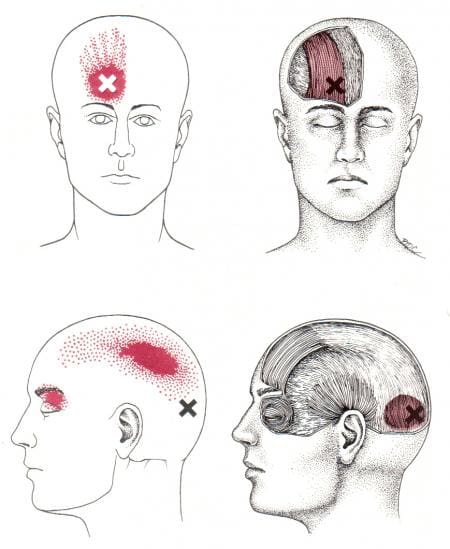Table of Contents
Introduction
Having headaches can affect anyone at any time, and various issues (both underlying and non-underlying) can play a part in the development. Factors like stress, allergies, traumatic events, or anxiety can trigger the causes of headaches to develop and can affect a person’s day-to-day schedule. Headaches can come in various forms and be the cause or symptom of other conditions. Many complain about headaches affecting their forehead, where the occipitofrontalis muscle resides, and explain to their doctors about a dull ache affecting them. To that point, the cause of the headache could affect them differently. Today’s article examines the occipitofrontalis muscle, how myofascial trigger pain affects this muscle, and ways to manage myofascial trigger pain associated with headaches. We refer patients to certified providers who specialize in musculoskeletal treatments to aid individuals suffering from myofascial trigger pain associated with headache symptoms affecting the occipitofrontalis muscle. We also guide our patients by referring them to our associated medical providers based on their examination when appropriate. We ensure to find that education is the solution to asking our providers insightful questions. Dr. Jimenez DC observes this information as an educational service only. Disclaimer
What Is The Occipitofrontalis Muscle?

Have you been experiencing unexplainable headaches that seem to affect your daily life? Do you feel muscle tension in your head or neck? Or do certain areas in your upper body seem tender to the touch? Many individuals suffer from headaches, and it could be due to myofascial trigger pain associated with the occipitofrontalis muscle. The occipitofrontalis muscle surprisingly plays an important part in the facial muscles. The occipitofrontalis muscle is the only muscle that can raise eyebrows, convey emotions, and provide non-verbal communication as part of its functionality to the head. The occipitofrontalis muscle has two different sections in the head that play different roles. Studies reveal that the occipital and frontal bellies have other actions but work together despite being connected to the galea aponeurotica. However, like all muscles in different body sections, various factors can affect the muscles to become tender and form multiple symptoms associated with pain.
How Does Myofascial Trigger Pain Affect The Occipitofrontalis?
When various factors begin to affect the occipitofrontalis muscle, it could potentially be at risk of developing myofascial trigger pain associated with headaches in the muscle. Studies reveal that myofascial trigger pain is a musculoskeletal disorder associated with muscle pain and tenderness that can be identified as latent or active. When the occipitofrontalis is affected by myofascial pain, it could potentially lead to tension-type headaches as a symptom. Studies reveal that headaches, especially tension headaches, are associated with trigger points in the head and neck muscles. Myofascial pain occurs when the muscles become overused and sensitive to the touch. The affected muscle then develops small nodules along the muscle fibers and can cause referred pain in a different body section. To that point, the affected muscle becomes hypersensitive due to an excess of nociceptive inputs from the peripheral nervous system, thus eliciting referred pain or muscle contraction. When this happens to the individual, they experience constant, throbbing pain in their forehead and try to find relief to diminish the pain.
Myofascial Exercises For Headaches-Video
Have you been feeling tension and pain in your neck or head? Do headaches seem to affect your daily activities? Does the slightest pressure seem to cause you pain in your muscles? Experiencing these symptoms may be a sign that you may have myofascial trigger pain associated with the head and neck that is causing headache-like pain along the occipitofrontalis muscle. The video above demonstrates various stretching exercises for headaches and migraines associated with myofascial trigger pain. Myofascial trigger pain associated with headaches can cause overlapping issues in the upper extremities of the body since myofascial trigger pain can mimic other conditions that affect the head and neck muscles. Known as referred pain, the underlying cause of pain affects a different body part than the actual location. Luckily, there are ways to manage myofascial trigger pain associated with headaches along the occipitofrontalis muscle.
How To Manage Myofascial Trigger Pain Associated With Headaches
There are many ways to manage headache symptoms associated with myofascial trigger pain along the occipitofrontalis muscle. Many people will take over-the-counter medicine to dull the pain, while others use a cold/hot pack to be placed on their forehead to relieve the tension caused by the headache. Those experiencing trigger point pain along the affected muscles that are not responding to the at-home treatments will go to a specialist that uses various techniques to manage myofascial trigger pain associated with headaches. Studies reveal that manual trigger point therapies for the head and neck may reduce the frequency, intensity, and duration of various headaches affecting the occipitofrontalis muscle. Other treatments that help manage myofascial pain associated with the occipitofrontal muscle include:
- Chiropractic care: Spinal misalignment or spinal subluxation in the cervical spine can potentially lead to the development of myofascial trigger pain associated with muscle pain
- Acupuncture: Dry needles are placed on the trigger points associated with the affected muscle to relieve pain
- Hot/cold compress: Ice or heat packs are placed on the affected muscle to relieve tension.
- Massage therapy: Deep tissue massage can relieve the inflamed area, reduce pain, and prevent trigger points from reemerging.
Utilizing these treatments can help prevent myofascial pain and manage headache symptoms associated with the muscle.
Conclusion
Headaches can affect anyone, and various issues can affect their development. Whether it is an underlying or non-underlying cause, multiple problems can trigger a headache to form and cause a dull ache in the affected muscle. One of the most common forms of headaches occurs in the occipitofrontalis muscle located in the forehead and near the base of the skull. The occipitofrontalis muscle is the only muscle that controls eyebrow movement, conveys emotions, and provides non-verbal communication as part of head functionality. However, like all muscles, the occipitofrontalis can become affected and potentially risk developing myofascial trigger pain. When this happens, the occipitofrontalis could develop tension-type headaches associated with myofascial trigger pain. Luckily available treatments are there to manage myofascial trigger pain associated with the occipitofrontalis muscle and alleviate headaches from the affected muscle.
References
Bérzin, F. “OCCIPITOFRONTALIS Muscle: Functional Analysis Revealed by Electromyography.” Electromyography and Clinical Neurophysiology, U.S. National Library of Medicine, 1989, pubmed.ncbi.nlm.nih.gov/2689156/.
Chatchawan, Uraiwan, et al. “Characteristics and Distributions of Myofascial Trigger Points in Individuals with Chronic Tension-Type Headaches.” Journal of Physical Therapy Science, The Society of Physical Therapy Science, Apr. 2019, www.ncbi.nlm.nih.gov/pmc/articles/PMC6451952/.
Falsiroli Maistrello, Luca, et al. “Effectiveness of Trigger Point Manual Treatment on the Frequency, Intensity, and Duration of Attacks in Primary Headaches: A Systematic Review and Meta-Analysis of Randomized Controlled Trials.” Frontiers in Neurology, Frontiers Media S.A., 24 Apr. 2018, www.ncbi.nlm.nih.gov/pmc/articles/PMC5928320/.
Moraska, Albert F, et al. “Responsiveness of Myofascial Trigger Points to Single and Multiple Trigger Point Release Massages: A Randomized, Placebo Controlled Trial.” American Journal of Physical Medicine & Rehabilitation, U.S. National Library of Medicine, Sept. 2017, www.ncbi.nlm.nih.gov/pmc/articles/PMC5561477/.
Pessino, Kenneth, et al. “Anatomy, Head and Neck, Frontalis Muscle – NCBI Bookshelf.” In: StatPearls [Internet]. Treasure Island (FL), StatPearls Publishing, 31 July 2021, www.ncbi.nlm.nih.gov/books/NBK557752/.
Disclaimer
Post Disclaimer
Professional Scope of Practice *
The information herein on "Myofascial Trigger Pain On The Occipitofrontalis Muscle" is not intended to replace a one-on-one relationship with a qualified health care professional or licensed physician and is not medical advice. We encourage you to make healthcare decisions based on your research and partnership with a qualified healthcare professional.
Blog Information & Scope Discussions
Welcome to El Paso's Wellness blog, where Dr. Alex Jimenez, DC, FNP-C, a board-certified Family Practice Nurse Practitioner (FNP-C) and Chiropractor (DC), presents insights on how our team is dedicated to holistic healing and personalized care. Our practice aligns with evidence-based treatment protocols inspired by integrative medicine principles, similar to those found on dralexjimenez.com, focusing on restoring health naturally for patients of all ages.
Our areas of chiropractic practice include Wellness & Nutrition, Chronic Pain, Personal Injury, Auto Accident Care, Work Injuries, Back Injury, Low Back Pain, Neck Pain, Migraine Headaches, Sports Injuries, Severe Sciatica, Scoliosis, Complex Herniated Discs, Fibromyalgia, Chronic Pain, Complex Injuries, Stress Management, Functional Medicine Treatments, and in-scope care protocols.
Our information scope is limited to chiropractic, musculoskeletal, physical medicine, wellness, contributing etiological viscerosomatic disturbances within clinical presentations, associated somato-visceral reflex clinical dynamics, subluxation complexes, sensitive health issues, and functional medicine articles, topics, and discussions.
We provide and present clinical collaboration with specialists from various disciplines. Each specialist is governed by their professional scope of practice and their jurisdiction of licensure. We use functional health & wellness protocols to treat and support care for the injuries or disorders of the musculoskeletal system.
Our videos, posts, topics, subjects, and insights cover clinical matters, issues, and topics that relate to and directly or indirectly support our clinical scope of practice.*
Our office has reasonably attempted to provide supportive citations and has identified the relevant research studies or studies supporting our posts. We provide copies of supporting research studies available to regulatory boards and the public upon request.
We understand that we cover matters that require an additional explanation of how they may assist in a particular care plan or treatment protocol; therefore, to discuss the subject matter above further, please feel free to ask Dr. Alex Jimenez, DC, APRN, FNP-BC, or contact us at 915-850-0900.
We are here to help you and your family.
Blessings
Dr. Alex Jimenez DC, MSACP, APRN, FNP-BC*, CCST, IFMCP, CFMP, ATN
email: coach@elpasofunctionalmedicine.com
Licensed as a Doctor of Chiropractic (DC) in Texas & New Mexico*
Texas DC License # TX5807
New Mexico DC License # NM-DC2182
Licensed as a Registered Nurse (RN*) in Texas & Multistate
Texas RN License # 1191402
ANCC FNP-BC: Board Certified Nurse Practitioner*
Compact Status: Multi-State License: Authorized to Practice in 40 States*
Graduate with Honors: ICHS: MSN-FNP (Family Nurse Practitioner Program)
Degree Granted. Master's in Family Practice MSN Diploma (Cum Laude)
Dr. Alex Jimenez, DC, APRN, FNP-BC*, CFMP, IFMCP, ATN, CCST
My Digital Business Card




